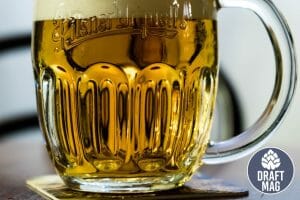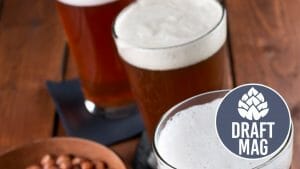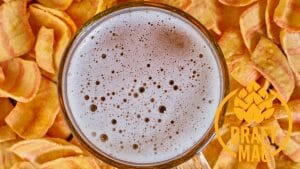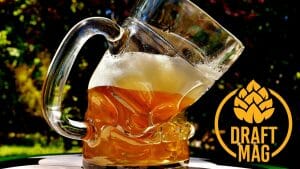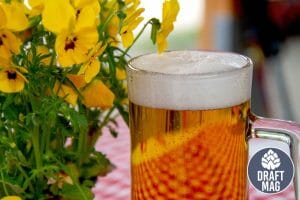Our Rolling Rock Review on a Premium Beer With History and Mystery
Our Rolling Rock Review investigates the taste, type, and facts about the American lager. The beer started successfully as a high-end brew for the working class in the late 1940s but soon went rolling through many changes in companies.

The easily drinkable beer has changed over the years and we are here to review what it tastes like now and whether you should consider trying a Rolling Rock beer or not.
What Is Rolling Rock?
Rolling Rock extra pale is an American lager-adjunct pale beer. The Rolling Rock alcohol content is low at 4.4 percent. The light beer forms a fine white head when poured into a beer glass. The first brewery of the Rolling Rock beer was located in Latrobe, Pennsylvania that was established as a family-owned business in 1939.
At present, the beer is manufactured by the giant beer company Anheuser-Busch InBev. With a blend of hops and the finest malted barley, the beer has a very distinctive taste and is light on the tongue. Rolling Rock is available in glass bottles of (12 oz.) and small cans (7 oz.). The remarkable green painted bottles make the beer stand out from typical brown or black beer glass bottles.
What Are the Ingredients in Rolling Rock?
According to the official website, the Rolling Rock Ingredients list includes;
- Malt
- Rice
- Hops
- Corn
- Brewer’s Yeast
- Water
What Does Rolling Rock Taste and Look Like?
In this section, you will discover the true flavors of Rolling Rock, and you’ll learn to appreciate its looks!
– Taste
The beer has a light hops aroma that feels pleasant. The flavors feel very light on the tongue, almost ethereal. The sweetness is evident with each sip while the bitterness from hop characters is lacking. This carbonated beer has a slight hop tang to it but mostly tastes like sweetened soft water.
– Appearance
Apart from the iconic green bottle packaging, the Rolling Rock has a pale straw color when poured into a beer glass. It ends with a fine white foam head. The texture looks very light and almost transparent which explains the watery flavor of the beer. The beer gets a golden yellow color from brewing it at a low temperature.
The brewing technique is an ancient one that provides the beer its unique taste and color.
Rolling Rock Nutrition Facts
Rolling Rock extra pale has a moderate calorie count, so health-conscious consumers can hardly find better alternatives. The Rolling Rock alcohol content is at 4.4 percent, which is quite low compared to other regular beers and makes it easy to drink more than one bottle.
A 12 fl oz bottle of the beer contains:
- Calories: 130
- Carbs: 9.8 grams
- Protein: 1.3 grams
- Fat: 0 gram
- Rolling Rock abv: 4.4 percent
Rolling Rock Extra Pale vs Pabst Blue Ribbon
Both Rolling Rock and Pabst Blue Ribbon are American lager beers that have a similar appearance of pale golden color. Despite their similar look, the two beers are far off each other when it comes to taste profile and flavors. The Pabst Blue Ribbon has spicy hops, corn syrup, and cultured yeast that is not present in Rolling Rock Extra Pale beer. Rolling Rock has an almost watery light taste whereas the Pabst Blue Ribbon gives off strong flavors.
The alcohol percentage in PBR is a little higher than the Rolling Rock but still comparable. Overall, both the beers are easy to drink but PBR has a taste personality and sweetness that Rolling Rock doesn’t.
Here’s a side by side comparison of Rolling Rock Extra Pale and Pabst Blue Ribbon:
– Rolling Rock Extra Pale vs Pabst Blue Ribbon
| Rolling Rock Extra Pale | Pabst Blue Ribbon | |
| Calories | 130 | 140 |
| Carbs | 9.8 | 12 |
| Alcohol Volume | 4.4 percent | 4.8 percent |
Rolling Rock Review on the Internet
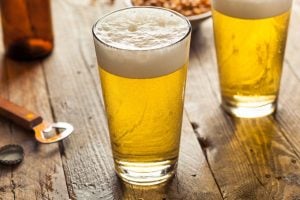
The majority of reviewers on the internet have mentioned how the original taste of the Rolling Rock is very different from what is manufactured and available in the market at present. The light lager beer once tasted unique and different from the average American lager but after it had been acquired by Anheuser-Busch InBev, the flavor and personality no longer exist.
Many drinkers suggest that the lightness of the Rolling Rock Extra Pale beer makes it easy and almost necessary to grab more drinks in order to feel the taste. As more bottles get finished easily, the brand also benefits from more sales. However, the drastic change in taste in the general public has made the Rolling Rock Extra Pale beer gradually lose its popularity among consumers and get criticized.
Facts About Rolling Rock
- The beer giant and present manufacturer of Rolling Rock, Anheuser-Busch, added a new variant known as the red lager version which is called Rolling Rock Red with an interesting addition of the number “3.”
- The Tito brothers had bought the Latrobe brewery in 1933 and launched the first beer in 1939. By 1974, the brewery company gained success.
- The very first variant of Rolling Rock, Light-n-Lo, was introduced in 1985.
- Rolling Rock beer is produced by a specific method known as “bottom-fermenting,” which involves fermenting a specific yeast at slow and at cold temperatures.
What Does 33 Mean on Rolling Rock Beer?
The Rolling Rock and the number 33 mystery is an interesting one. Most people on the internet have come up with their own theories related to the number 33 that is written on each bottle of Rolling Rock beer. The former CEO of Latrobe Brewing suggested how the number 33 could refer to the word count of the beer’s original pledge of quality but the exact reason is still unknown.
The official website of Rolling Rock states the different theories that people came up with:
- One of the founding members of the brewery had bet $33 on a horse numbered #33 and won the bet at the horse track.
- This beer goes through 33 different steps while brewing.
- One of the brothers of the brewery won the toss and titled the bottle 33 after his personal horse number.
- This beer is brewed at a temperature of 33 degrees Celsius.
- The number of steps (33) that separated the brewery floor from the brewmaster’s office.
- Groundhog’s Day on the 33rd day of the year, an occasion celebrated in Pennsylvania.
- A total sum of all the letters in Rolling Rock’s ingredients list.
- The year 1933 when the prohibition on beer had ended.
- 33 different springs that flow into the reservoir of the brewery and are used in making the beer.
- Freemason’s theory.
Does Rolling Rock Get You Drunk?
Getting drunk by drinking Rolling Rock beer will require time and too many bottles. Since the alcohol content in the beer is limited to only 4.4 percent, quite low compared to most lagers, and for easy drinking, you’d need to drink many bottles to get drunk.
What Beer Is Comparable To Rolling Rock?
There are plenty of light lager beers available in the market that are comparable to the Rolling Rock Extra Pale, including popular options like Bud Light, Coors Light, Miller Lite, and Keystone.
Where Is Rolling Rock Beer Manufactured?
Since Anheuser-Busch InBev took over the beer brand in 2006, the Rolling Rock brewery is currently located in Newark, New Jersey.
Is Rolling Rock Healthy?
The Rolling Rock is a better and healthy option for health-conscious drinkers as it contains low alcohol that translates into low calories as well. Despite the fact that Rolling Rock’s flavor profile can be disappointing to some, the good side of the sweetened water-like beer is its easy-drinking characteristics with a refreshing taste. Other variants of the Rolling Rock may not offer the same health benefits.
FAQ
What does extra pale mean in Rolling Rock beer?
“Extra pale” in Rolling Rock beer refers to a lighter color and body achieved through the use of high-quality hops and a longer brewing process.
What does Rolling Rock Extra Pale taste like?
Rolling Rock Extra Pale has a crisp and refreshing taste with subtle hop bitterness and a light malt sweetness. Its light body and carbonation make it easy to drink, while its smooth finish leaves a clean aftertaste.
Does rolling rock have a light beer?
Conclusion
The Rolling Rock Extra Pale beer is light and a go-to beer that is easy to consume. Let’s sum up the main ideas that we explored about Rolling Rock Extra Pale beer:
- The Rolling Rock Extra Pale is an American lager-adjunct light beer with a pale straw color.
- With a low alcohol content of 4.4 percent, the beer has fewer calories when compared to other lagers and is a good option for health-conscious drinkers.
- The main ingredients present in the beer are malt, rice, hops, corn, brewer’s yeast, and water.
- With pronounced sweet flavors and soft water lightness, the beer is very light on the taste buds and very easy to drink.
- Rolling Rock extra pale comes in iconic green bottles and gives off a white head when poured correctly.
- The two-digit number “33” painted on the green glass bottles of the beer is a popular mystery, with many theories surrounding its origin.
- When compared with the Pabst Blue Ribbon (PBR) beer, the Rolling Rock falls behind due to its lack of taste profile.
- Many consumers have observed a drastic downfall in the taste of the newly produced Rolling Rock that has deteriorated over the years.
- Originally owned by the Tito brothers, the Rolling Rock beers have a long history and many changes of owners.
- You’d need many bottles of Rocking Roll to get drunk since it has a low alcohol percentage.

For consumers who need a refreshing, light, and sweet beer to sip on a sunny day or while spending time with friends, the Rocking Roll fits right into those moments with its low alcohol percentage, calories, and taste profile. The original taste of the Rolling Rock Extra Pale beer may not be present in new brewing but it is still a refreshing and easy drink for all.

